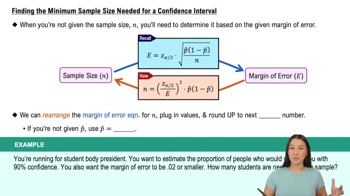Table of contents
- 1. Intro to Stats and Collecting Data55m
- 2. Describing Data with Tables and Graphs1h 55m
- 3. Describing Data Numerically1h 45m
- 4. Probability2h 16m
- 5. Binomial Distribution & Discrete Random Variables2h 33m
- 6. Normal Distribution and Continuous Random Variables1h 38m
- 7. Sampling Distributions & Confidence Intervals: Mean1h 3m
- 8. Sampling Distributions & Confidence Intervals: Proportion1h 12m
- 9. Hypothesis Testing for One Sample1h 1m
- 10. Hypothesis Testing for Two Samples2h 8m
- 11. Correlation48m
- 12. Regression1h 4m
- 13. Chi-Square Tests & Goodness of Fit1h 20m
- 14. ANOVA1h 0m
8. Sampling Distributions & Confidence Intervals: Proportion
Confidence Intervals for Population Proportion
Struggling with Statistics?
Join thousands of students who trust us to help them ace their exams!Watch the first videoMultiple Choice
Your company has asked you to estimate the proportion of people who prefer the color red over other primary colors for manufacturing purposes. If they want the estimate to be within .01 of the true proportion with 95% confidence, how many people should you survey?
A
1825
B
6766
C
9604
D
97
 Verified step by step guidance
Verified step by step guidance1
Understand the problem: You need to determine the sample size required to estimate the proportion of people who prefer the color red with a specified margin of error and confidence level.
Identify the formula for sample size calculation in proportion estimation: The formula is \( n = \frac{{Z^2 \, p \, (1-p)}}{{E^2}} \), where \( n \) is the sample size, \( Z \) is the Z-score corresponding to the confidence level, \( p \) is the estimated proportion, and \( E \) is the margin of error.
Determine the Z-score for a 95% confidence level: The Z-score for 95% confidence is typically 1.96.
Assume an estimated proportion \( p \): If no prior estimate is available, use \( p = 0.5 \) as it maximizes the sample size.
Substitute the values into the formula: Use \( Z = 1.96 \), \( p = 0.5 \), and \( E = 0.01 \) to calculate the sample size \( n \).

 5:45m
5:45mWatch next
Master Constructing Confidence Intervals for Proportions with a bite sized video explanation from Patrick
Start learningRelated Videos
Related Practice





